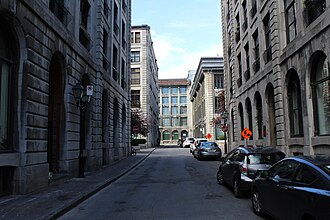Old Montreal: Difference between revisions
imported>Shawn Goldwater (WP content, though heavily edited) |
mNo edit summary |
||
| (11 intermediate revisions by 6 users not shown) | |||
| Line 1: | Line 1: | ||
'''Old Montreal''' is a [[ | {{subpages}} | ||
{{Image|Vieux-Montréal, Montreal, Quebec (30068128575).jpg|right|300px|Old Montreal, 2016.}} | |||
'''Old Montreal''' is a historic district in the [[Canada|Canadian]] city of [[Montreal, Quebec]], whose origins date back to [[New France]]. | |||
European settlement in the area first began | European settlement in the area first began 1605, when [[Samuel de Champlain]] set up a [[fur trade|fur trading post]] at [[Place Royale]], at the confluence of the [[Saint Lawrence River]] and the long-vanished Saint Pierre River, near the Iroquois settlement of [[Hochelaga]]. | ||
It was not until | It was not until 1639 that a permanent settlement was created by [[Jérôme Le Royer]]. Under the authority of the [[Roman Catholicism|Roman Catholic]] ''[[Société Notre-Dame]]'', [[Paul Chomedey de Maisonneuve]], [[Jeanne Mance]] and a few French colonists set up a mission named "Ville Marie" on May 17, 1642. On January 4th, 1648, de Maisonneuve granted [[Pierre Gadois]] the first concession of land—some 40 acres. In November of 1653, another 140 individuals arrived to enlarge the settlement. | ||
The town was fortified in | The town was fortified in 1725 and remained until French control until 1760, when it was surrendered to the English at the conclusion of the [[French and Indian War]]. | ||
The area used to be the city's downtown, with Saint James Street (now renamed Saint Jacques Street) as the financial centre of Canada. The 20th century saw the expansion of the city northwards, away from the riverfront. | The area used to be the city's downtown, with Saint James Street (now renamed Saint Jacques Street) as the financial centre of Canada. The 20th century saw the expansion of the city northwards, away from the riverfront. | ||
| Line 12: | Line 14: | ||
Key tourist sites in the district include [[Montreal City Hall]], the [[Place Jacques-Cartier]] public square, [[Bonsecours Market]] and the [[Château Ramezay]] museum. | Key tourist sites in the district include [[Montreal City Hall]], the [[Place Jacques-Cartier]] public square, [[Bonsecours Market]] and the [[Château Ramezay]] museum. | ||
Further west, the urban square [[Place d'Armes]] is dominated by the [[Notre-Dame Basilica]], the old [[Bank of Montreal Head Office, Montreal|Bank of Montreal Head Office]], the [[Art deco]] [[Aldred Building]] and the | Further west, the urban square [[Place d'Armes]] is dominated by the [[Notre-Dame Basilica]], the old [[Bank of Montreal Head Office, Montreal|Bank of Montreal Head Office]], the [[Art deco]] [[Aldred Building]] and the 1888 [[New York Life Building, Montreal|New York Life Building]], the oldest skyscraper in Canada. | ||
The southwest of the old city contains archeological remains of Montreal's first townsite, around Place Royale and [[Place d'Youville]], and is the site of the [[Pointe-à-Callière]] archeological museum. | The southwest of the old city contains archeological remains of Montreal's first townsite, around Place Royale and [[Place d'Youville]], and is the site of the [[Pointe-à-Callière]] archeological museum. | ||
| Line 18: | Line 20: | ||
The old town's riverbank has been developed as the [[Old Port of Montreal]], a public space with a [[science centre]], marina and other attractions. | The old town's riverbank has been developed as the [[Old Port of Montreal]], a public space with a [[science centre]], marina and other attractions. | ||
== | ==Attribution== | ||
{{WPAttribution}} | |||
==Footnotes== | |||
<references> | |||
</references>[[Category:Suggestion Bot Tag]] | |||
Latest revision as of 12:00, 28 September 2024
Old Montreal is a historic district in the Canadian city of Montreal, Quebec, whose origins date back to New France.
European settlement in the area first began 1605, when Samuel de Champlain set up a fur trading post at Place Royale, at the confluence of the Saint Lawrence River and the long-vanished Saint Pierre River, near the Iroquois settlement of Hochelaga.
It was not until 1639 that a permanent settlement was created by Jérôme Le Royer. Under the authority of the Roman Catholic Société Notre-Dame, Paul Chomedey de Maisonneuve, Jeanne Mance and a few French colonists set up a mission named "Ville Marie" on May 17, 1642. On January 4th, 1648, de Maisonneuve granted Pierre Gadois the first concession of land—some 40 acres. In November of 1653, another 140 individuals arrived to enlarge the settlement.
The town was fortified in 1725 and remained until French control until 1760, when it was surrendered to the English at the conclusion of the French and Indian War.
The area used to be the city's downtown, with Saint James Street (now renamed Saint Jacques Street) as the financial centre of Canada. The 20th century saw the expansion of the city northwards, away from the riverfront.
Key attractions
Key tourist sites in the district include Montreal City Hall, the Place Jacques-Cartier public square, Bonsecours Market and the Château Ramezay museum.
Further west, the urban square Place d'Armes is dominated by the Notre-Dame Basilica, the old Bank of Montreal Head Office, the Art deco Aldred Building and the 1888 New York Life Building, the oldest skyscraper in Canada.
The southwest of the old city contains archeological remains of Montreal's first townsite, around Place Royale and Place d'Youville, and is the site of the Pointe-à-Callière archeological museum.
The old town's riverbank has been developed as the Old Port of Montreal, a public space with a science centre, marina and other attractions.
Attribution
- Some content on this page may previously have appeared on Wikipedia.
